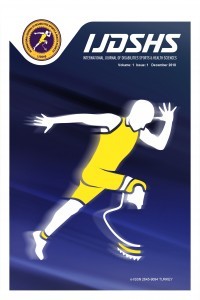Development of the Workplace Work Environment Ergonomics Scale for Nurses
Development of the Workplace Work Environment Ergonomics Scale for Nurses
Ergonomics, Ergonomics Scale Nursing, Physical workload, Work-related musculoskeletal disorders,
___
- AlHazim, S. S., Al-Otaibi, S. T., & Herzallah, N. H. (2022). Knowledge, Attitudes, and Practices Regarding Ergonomic Hazards Among Healthcare Workers in a Saudi Government Hospital. Journal of Multidisciplinary Healthcare, 1771-1778.
- Apple, B., & Letvak, S. (2021). Ergonomic Challenges in the Perioperative Setting. AORN Journal, 113(4), 339-348.
- Harrington, D. (2009). Confirmatory Factor Analysis. Oxford University Press.
- Costello, A. B., & Osborne, J. (2005). Best practices in exploratory factor analysis: Four recommendations for getting the most from your analysis. Practical assessment, research, and evaluation, 10(1), 7.
- Karakoç, A. G. D. F. Y., & Dönmez, L. (2014). Fundamental Principles in Scale Development Studies. Tıp Eğitimi Dünyası, 13(40), 39-49.
- Kılıç, S. (2016). Cronbach's Alpha Reliability Coefficient. Journal of Mood Disorders.
- Lawshe, C. H. (1975). A Quantitative Approach to Content Validity. Personnel Psychology, 28(4), 563-575.
- Mokarami, H., Eskandari, S., Cousins, R., Salesi, M., Kazemi, R., Razeghi, M., & Choobineh, A. (2021). Development and Validation of a Nurse Station Ergonomics Assessment (NSEA) Tool. BMC Nursing, 20(1), 1-12.
- Nguyen, T. T., Nguyen, T. H., Hoang, D. L., Hoang, T. G., & Pham, M. K. (2022). Effectiveness of Interventions to Prevent Musculoskeletal Disorders Among District Hospital Nurses in Vietnam. BioMed Research International, 2022.
- Polat, F., Boz, D., Çetindere, F. A., & Duran, C. (2021). Workplace Ergonomics Scale.
- Seçer, İ. (2013). Practical Data Analysis with SPSS and LISREL: Analysis and Reporting.
- Soler-Font, M., Ramada, J. M., van Zon, S. K., Almansa, J., Bültmann, U., Serra, C., & ISR Team (2019). Multifaceted Intervention for the Prevention and Management of Musculoskeletal Pain in Nursing Staff: Results of a Cluster Randomized Controlled Trial. PLoS One, 14(11), e0225198.
- Şeker, H., & Gençdoğan, B. (2014). Development of Psychology and Measurement Tool in Education. Istanbul: Nobel Publishing.
- Şencan, H. (2005). Reliability and Validity in Social and Behavioral Measurements. Ankara: Seçkin Publishing. Webster, C. S., & Weller, J. M. (2021). Data Visualization and Cognitive Ergonomics in Anaesthesia and Healthcare. British Journal of Anaesthesia, 126(5), 913-915.
- Webster, C. S., & Weller, J. M. (2021). Data Visualization and Cognitive Ergonomics in Anaesthesia and Healthcare. British Journal of Anaesthesia, 126(5), 913-915.
- Westergren, E., Ludvigsen, M. S., & Lindberg, M. (2020). Associations Between Materials Used and Work-Related Musculoskeletal Hand Complaints Among Haemodialysis Nurses. Journal of Renal Care, 46(3), 185-192.
- Yaşlıoğlu, M. M. (2017). Factor Analysis and Validity in Social Sciences: The Usage of Exploratory and Confirmatory Factor Analysis. İstanbul University Business Faculty Journal, 46, 74-85.
- Yeşilyurt, S., & Çapraz, C. (2018). A Road Map for the Content Validity Used in Scale Development Studies. Erzincan University Journal of Education Faculty, 20(1), 251-264.
- Yilmaz, T., & Isik Andsoy, I. (2022). Musculoskeletal System Disorders Among Surgical Nurses Related to the Health Industry in Northwestern Turkey: A Cross-Sectional Study. International Journal of Occupational Safety and Ergonomics, 28(4), 2119-2124.
- Zakerian, S. A., Afzalinejhad, M., Mahmodi, M., & Sheibani, N. (2021). Determining the Efficiency of Ergonomic Belt During Patient Handling and its Effect on Reducing Musculoskeletal Disorders in Nurses. SAGE Open Nursing, 7, 23779608211057939.
- Yayın Aralığı: Yılda 3 Sayı
- Başlangıç: 2018
- Yayıncı: Nevzat DEMİRCİ
Does Function Level of Individuals With Autism Spectrum Disorder Affect The Family Impact?
Nazan ÖZTÜRK, Gül Öznur KARABIÇAK, Uğur CAVLAK
Mohan Kumar PASUPULETİ, Divya Naga Lakshmi P, Jyothirmai KONERU, Swathi P, Karteek Varma PV, Sai Amulya KUKUTLA
İsmail AYDIN, İbrahim GÜMÜŞBOĞA
Caregiving Children with Visually Impairments: Occupational Balance and Quality of Life Perspective
Güleser GÜNEY YILMAZ, Hatice ABAOĞLU, Tarık DEMİROK, Esra AKI
Hale Havva KAĞANSOY KOCAİSMAİL, Yasemin SORAKIN
Halil İbrahim BULGUROĞLU, Merve BULGUROĞLU, Cansu GEVREK, Serenay ZORLU, Sezen DİNCER, Kübra KENDAL
Tezel YILDIRIM ŞAHAN, Duygu TÜRKER, Büşra Nur AKSU, Melike ÖZCAN, Elif YAVAŞ, Seda BİCİCİ ULUŞAHİN
Determination of Anthropometric Measurements and Nutritional Status of Wheelchair Basketball Players
Ayşe Hümeyra İSLAMOĞLU, Esra ÖNDAR, Tuğçe YILDIRIM, Zehra KARTAL
